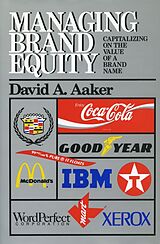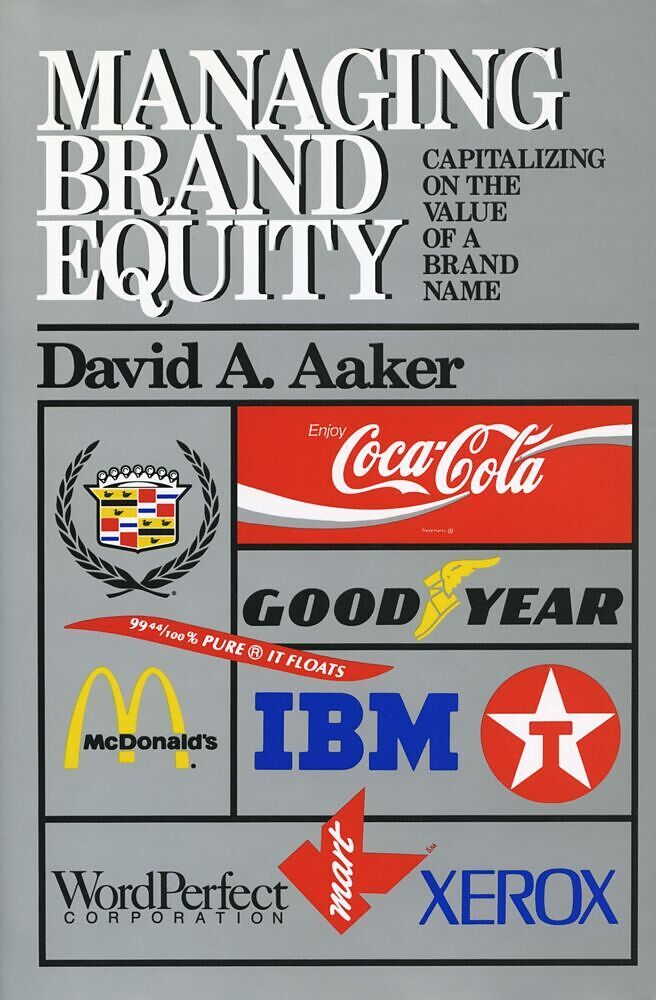Managing Brand Equity
Einband:
Fester Einband
EAN:
9780029001011
Untertitel:
Capitalizing on the Value of a Brand Name
Genre:
Werbung & Marketing
Autor:
David A. Aaker
Herausgeber:
FREE PR
Anzahl Seiten:
299
Erscheinungsdatum:
01.05.1991
ISBN:
978-0-02-900101-1
In a fascinating and insightful examination of the phenomenon of brand equity, Aaker provides a clear and well-defined structure of the relationship between a brand and its symbol and slogan, as well as each of the five underlying assets, which will clarify for managers exactly how brand equity does contribute value.
The most important assets of any business are intangible: its company name, brands, symbols, and slogans, and their underlying associations, perceived quality, name awareness, customer base, and proprietary resources such as patents, trademarks, and channel relationships. These assets, which comprise brand equity, are a primary source of competitive advantage and future earnings, contends David Aaker, a national authority on branding. Yet, research shows that managers cannot identify with confidence their brand associations, levels of consumer awareness, or degree of customer loyalty. Moreover in the last decade, managers desperate for short-term financial results have often unwittingly damaged their brands through price promotions and unwise brand extensions, causing irreversible deterioration of the value of the brand name. Although several companies, such as Canada Dry and Colgate-Palmolive, have recently created an equity management position to be guardian of the value of brand names, far too few managers, Aaker concludes, really understand the concept of brand equity and how it must be implemented.
The author opens each chapter with a historical analysis of either the success or failure of a particular company's attempt at building brand equity: the fascinating Ivory soap story; the transformation of Datsun to Nissan; the decline of Schlitz beer; the making of the Ford Taurus; and others. Finally, citing examples from many other companies, Aaker shows how to avoid the temptation to place short-term performance before the health of the brand and, instead, to manage brands strategically by creating, developing, and exploiting each of the five assets in turn
Autorentext
David A. Aaker is the Vice-Chairman of Prophet, Professor Emeritus of Marketing Strategy at the Haas School of Business, University of California at Berkeley, Advisor to Dentsu, Inc., and a recognized authority on brands and brand management. The winner of the Paul D. Converse Award for outstanding contributions to the development of the science of marketing and the Vijay Mahajan Award for Career Contributions to Marketing Strategy, he has published more than ninety articles and eleven books, including Strategic Market Management, Managing Brand Equity, Building Strong Brands, and Brand Leadership (coauthored with Eric Joachimsthaler).
Klappentext
The most important assets of any business are intangible: its company name, brands, symbols, and slogans, and their underlying associations, perceived quality, name awareness, customer base, and proprietary resources such as patents, trademarks, and channel relationships. These assets, which comprise brand equity, are a primary source of competitive advantage and future earnings, contends David Aaker, a national authority on branding. Yet, research shows that managers cannot identify with confidence their brand associations, levels of consumer awareness, or degree of customer loyalty. Moreover in the last decade, managers desperate for short-term financial results have often unwittingly damaged their brands through price promotions and unwise brand extensions, causing irreversible deterioration of the value of the brand name. Although several companies, such as Canada Dry and Colgate-Palmolive, have recently created an equity management position to be guardian of the value of brand names, far too few managers, Aaker concludes, really understand the concept of brand equity and how it must be implemented. In a fascinating and insightful examination of the phenomenon of brand equity, Aaker provides a clear and well-defined structure of the relationship between a brand and its symbol and slogan, as well as each of the five underlying assets, which will clarify for managers exactly how brand equity does contribute value. The author opens each chapter with a historical analysis of either the success or failure of a particular company's attempt at building brand equity: the fascinating Ivory soap story; the transformation of Datsun to Nissan; the decline of Schlitz beer; the making ofthe Ford Taurus; and others. Finally, citing examples from many other companies, Aaker shows how to avoid the temptation to place short-term performance before the health of the brand and, instead, to manage brands strategically by creating, developing, and exploiting each of
Zusammenfassung
An examination of the phenomenon of brand equity, providing a structure of the relationship between a brand and its symbol and slogan, as well as each of the five underlying assets: company name; brands, symbols and slogans; perceived quality; name awareness; and customer base.
Leseprobe
Chapter 1: What Is Brand Equity?
A product is something that is made in a factory; a brand is something that is bought by a customer. A product can be copied by a competitor; a brand is unique. A product can be quickly outdated; a successful brand is timeless.
Stephen King
WPP Group, London
THE IVORY STORY
One Sunday in 1879 Harley Procter, one of the founders of the candle and soap firm Procter & Gamble (P&G), heard a sermon based on the Forty-fifth Psalm, "All thy garments smell of myrrh, and aloes, and cassia, out of ivory palaces." The word "ivory" stuck in his mind -- and became the name of the firm's white soap.
In December, 1881, P&G ran their first Ivory ad in a religious weekly, stating that the soap "floated" and that it was "99 44/100% pure," a dual claim which has become one of the most famous ad slogans ever. That ad is shown in Figure 1-1. Figure 1-2 shows a 1920 Ivory ad illustrating the consistency of the positioning over time. Note the imagery created by the forest, the barefoot girl, and the clear water.
The purity claim was supported by a chemist, who had tested Ivory and found that only 56/100% contained impurities. The flotation property, first created by a production mistake which fed air into the soap mixture, was discovered by customers -- who attempted to reorder the "floating" soap.
Ivory was a remarkable product in a time in which most soaps were yellow or brown, irritated skin, and damaged clothes. The fact that it floated had practical value to those used to being frustrated by trying to find their soap in the bath water. It was thus well positioned -- a soap that was pure, was mild, and floated. From the outset, the fact that it was mild enough for babies was stressed, and babies were often featured in the advertising. The claims of purity and mildness were supported by the white color, the name Ivory, the twin slogans, and the association with babies. The soap's brand name, along with its distinctive wrapping, gave customers confidence that they were getting the mild, gentle soap they wanted. The "aggressive" 1882 national advertising budget of $11,000 provided a start toward high brand awareness, and customer confidence that the manufacturer was backing the product and would stand behind it.
Ivory, now over 110 years old, is a prime example of the value of creating and sustaining brand equity. Brand equity will be carefully defined and detailed later in this chapter. Briefly, it is a set of assets such as name awareness, loyal customers, perceived quality, and associations (e.g. being "pure" and "it floats") that are linked to the brand (its name and symbol) and add (or subtract) value to the product or service being offered.
Curiously, in 1885 a yellow soap named Sunlight, when introduced to dreary, sun-starved E…

Leider konnten wir für diesen Artikel keine Preise ermitteln ...
billigbuch.ch sucht jetzt für Sie die besten Angebote ...
Die aktuellen Verkaufspreise von 6 Onlineshops werden in Realtime abgefragt.
Sie können das gewünschte Produkt anschliessend direkt beim Anbieter Ihrer Wahl bestellen.
Loading...
Die aktuellen Verkaufspreise von 6 Onlineshops werden in Realtime abgefragt.
Sie können das gewünschte Produkt anschliessend direkt beim Anbieter Ihrer Wahl bestellen.
| # | Onlineshop | Preis CHF | Versand CHF | Total CHF | ||
|---|---|---|---|---|---|---|
| 1 | Seller | 0.00 | 0.00 | 0.00 |
